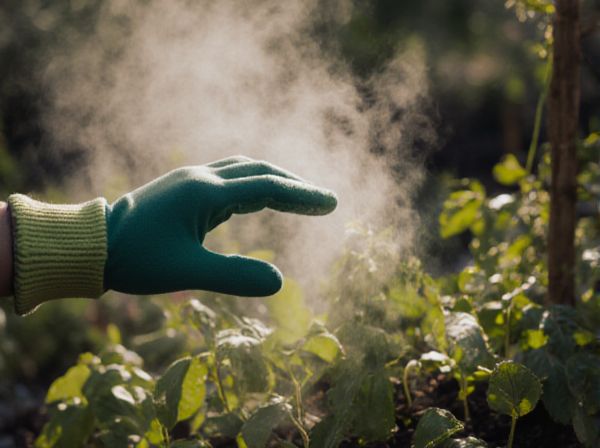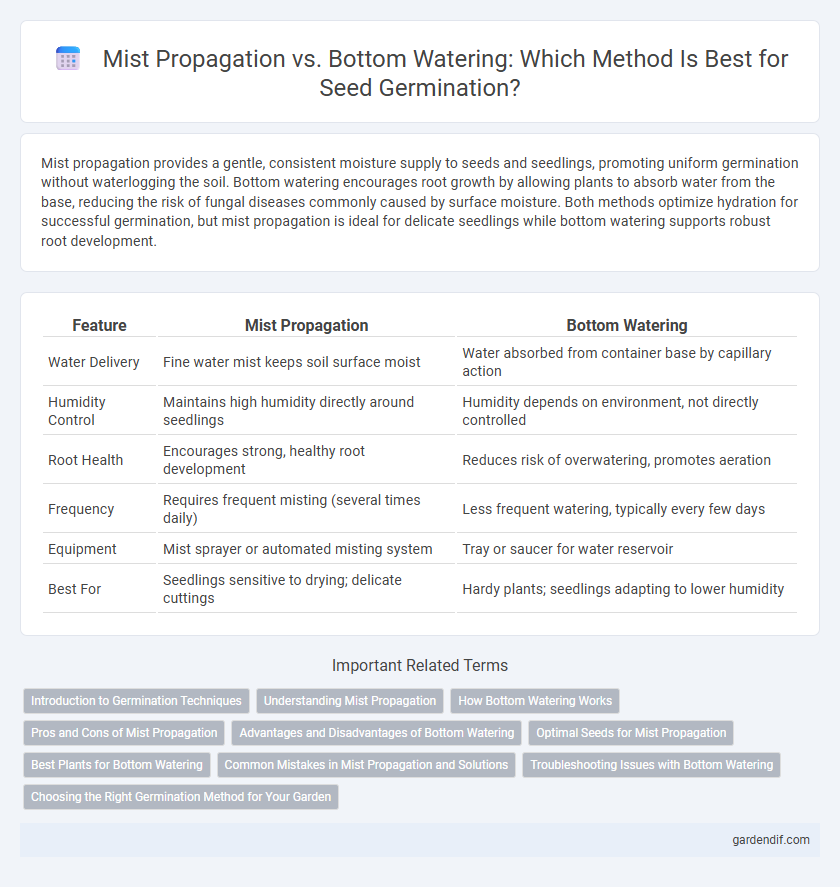
Mist Propagation vs Bottom Watering Illustration
Mist propagation provides a gentle, consistent moisture supply to seeds and seedlings, promoting uniform germination without waterlogging the soil. Bottom watering encourages root growth by allowing plants to absorb water from the base, reducing the risk of fungal diseases commonly caused by surface moisture. Both methods optimize hydration for successful germination, but mist propagation is ideal for delicate seedlings while bottom watering supports robust root development.
Table of Comparison
| Feature | Mist Propagation | Bottom Watering |
|---|---|---|
| Water Delivery | Fine water mist keeps soil surface moist | Water absorbed from container base by capillary action |
| Humidity Control | Maintains high humidity directly around seedlings | Humidity depends on environment, not directly controlled |
| Root Health | Encourages strong, healthy root development | Reduces risk of overwatering, promotes aeration |
| Frequency | Requires frequent misting (several times daily) | Less frequent watering, typically every few days |
| Equipment | Mist sprayer or automated misting system | Tray or saucer for water reservoir |
| Best For | Seedlings sensitive to drying; delicate cuttings | Hardy plants; seedlings adapting to lower humidity |
Introduction to Germination Techniques
Mist propagation maintains consistent moisture on seed surfaces, promoting rapid germination by preventing drying without waterlogging. Bottom watering delivers water directly to the root zone, encouraging strong root development while minimizing fungal issues on seedlings. Both techniques support optimal seed germination environments but differ in moisture application and disease management efficacy.
Understanding Mist Propagation
Mist propagation provides a controlled humid environment that promotes seed germination by maintaining moisture on the seed surface, preventing drying out without waterlogging. This method enhances oxygen availability compared to bottom watering, reducing the risk of fungal infections during the delicate early growth stages. Understanding mist propagation is crucial for optimizing germination rates and ensuring healthy seedling development.
How Bottom Watering Works
Bottom watering promotes healthy germination by delivering water directly to the root zone, ensuring consistent moisture without overhydrating the seed surface. This method uses a tray or reservoir to allow the soil or growing medium to absorb water upward through capillary action, encouraging strong root development. Maintaining uniform moisture levels reduces the risk of damping-off disease and improves seedling vigor during early growth stages.
Pros and Cons of Mist Propagation
Mist propagation offers excellent humidity control, ensuring seeds and cuttings remain moist without waterlogging, which accelerates germination and reduces the risk of fungal infections. However, mist propagation systems can be costly to set up and require regular maintenance to prevent bacterial buildup and system clogging. Compared to bottom watering, mist propagation demands more precise environmental monitoring to maintain optimal moisture levels and prevent drying out.
Advantages and Disadvantages of Bottom Watering
Bottom watering offers consistent moisture delivery directly to the root zone, reducing the risk of fungal diseases caused by wet foliage. This method conserves water by limiting evaporation and ensures even soil saturation, promoting healthy root development. However, bottom watering may lead to salt buildup in the soil and requires careful monitoring to prevent overwatering and root rot.
Optimal Seeds for Mist Propagation
Mist propagation excels with fine, lightweight seeds such as lettuce, begonias, and ferns that require consistent moisture without soil saturation. This method maintains high humidity and gentle moisture levels, promoting quicker germination and reducing damping-off risks common in bottom watering. Seeds with delicate coats or that are prone to rot benefit most from mist propagation's controlled environment.
Best Plants for Bottom Watering
Bottom watering is especially effective for plants like African violets, ferns, and begonias that prefer consistent moisture without wetting their foliage, reducing the risk of fungal diseases and promoting healthier root development. Unlike mist propagation, which is ideal for delicate cuttings that require high humidity, bottom watering ensures the soil is evenly moist from the roots up, encouraging robust germination and growth in moisture-sensitive species. This method also benefits seedlings with fragile stems by preventing over-saturation and providing a steady supply of water directly to the root zone.
Common Mistakes in Mist Propagation and Solutions
Overwatering is a common mistake in mist propagation, leading to fungal infections and root rot; adjusting mist frequency to maintain moist but not soggy conditions is essential. Insufficient air circulation often causes mold growth; incorporating fans or opening vents improves airflow and reduces humidity buildup. Using unsterilized water or containers increases contamination risk, so sterilizing equipment and using clean water helps prevent disease.
Troubleshooting Issues with Bottom Watering
Bottom watering during germination helps maintain consistent moisture but can cause problems like overwatering, leading to root rot and fungal growth. Poor drainage or waterlogged soil may suffocate seeds, preventing proper sprouting and causing seed decay. To troubleshoot, ensure containers have adequate drainage and allow the soil surface to dry slightly between waterings to promote healthy root development.
Choosing the Right Germination Method for Your Garden
Mist propagation promotes consistent moisture on seed surfaces, reducing the risk of fungal diseases during germination, making it ideal for delicate seeds that require high humidity. Bottom watering delivers water directly to the root zone, encouraging stronger root development and minimizing surface mold, which benefits larger or more robust seeds. Selecting the right germination method depends on seed type, moisture requirements, and disease susceptibility to optimize seedling growth.
Mist Propagation vs Bottom Watering Infographic

 gardendif.com
gardendif.com